Go Here to Read this Fast! Everything new on Disney Plus in January 2025
Originally appeared here:
Everything new on Disney Plus in January 2025
Go Here to Read this Fast! Everything new on Disney Plus in January 2025
Originally appeared here:
Everything new on Disney Plus in January 2025

This article describes the architecture and design of a Home Assistant (HA) integration called home-generative-agent. This project uses LangChain and LangGraph to create a generative AI agent that interacts with and automates tasks within a HA smart home environment. The agent understands your home’s context, learns your preferences, and interacts with you and your home to accomplish activities you find valuable. Key features include creating automations, analyzing images, and managing home states using various LLMs (Large Language Models). The architecture involves both cloud-based and edge-based models for optimal performance and cost-effectiveness. Installation instructions, configuration details, and information on the project’s architecture and the different models used are included and can be found on the home-generative-agent GitHub. The project is open-source and welcomes contributions.
These are some of the features currently supported:
This is my personal project and an example of what I call learning-directed hacking. The project is not affiliated with my work at Amazon nor am I associated with the organizations responsible for Home Assistant or LangChain/LangGraph in any way.
Creating an agent to monitor and control your home can lead to unexpected actions and potentially put your home and yourself at risk due to LLM hallucinations and privacy concerns, especially when exposing home states and user information to cloud-based LLMs. I have made reasonable architectural and design choices to mitigate these risks, but they cannot be completely eliminated.
One key early decision was to rely on a hybrid cloud-edge approach. This enables the use of the most sophisticated reasoning and planning models available, which should help reduce hallucinations. Simpler, more task-focused edge models are employed to further minimize LLM errors.
Another critical decision was to leverage LangChain’s capabilities, which allow sensitive information to be hidden from LLM tools and provided only at runtime. For instance, tool logic may require using the ID of the user who made a request. However, such values should generally not be controlled by the LLM. Allowing the LLM to manipulate the user ID could pose security and privacy risks. To mitigate this, I utilized the InjectedToolArg annotation.
Additionally, using large cloud-based LLMs incurs significant cloud costs, and the edge hardware required to run LLM edge models can be expensive. The combined operational and installation costs are likely prohibitive for the average user at this time. An industry-wide effort to “make LLMs as cheap as CNNs” is needed to bring home agents to the mass market.
It is important to be aware of these risks and understand that, despite these mitigations, we are still in the early stages of this project and home agents in general. Significant work remains to make these agents truly useful and trustworthy assistants.
Below is a high-level view of the home-generative-agent architecture.
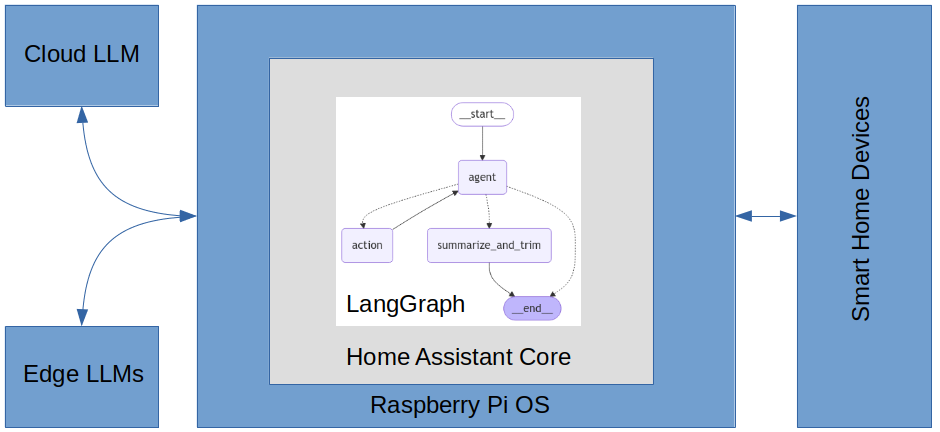
The general integration architecture follows the best practices as described in Home Assistant Core and is compliant with Home Assistant Community Store (HACS) publishing requirements.
The agent is built using LangGraph and uses the HA conversation component to interact with the user. The agent uses the Home Assistant LLM API to fetch the state of the home and understand the HA native tools it has at its disposal. I implemented all other tools available to the agent using LangChain. The agent employs several LLMs, a large and very accurate primary model for high-level reasoning, smaller specialized helper models for camera image analysis, primary model context summarization, and embedding generation for long-term semantic search. The primary model is cloud-based, and the helper models are edge-based and run under the Ollama framework on a computer located in the home.
The models currently being used are summarized below.
LangGraph powers the conversation agent, enabling you to create stateful, multi-actor applications utilizing LLMs as quickly as possible. It extends LangChain’s capabilities, introducing the ability to create and manage cyclical graphs essential for developing complex agent runtimes. A graph models the agent workflow, as seen in the image below.
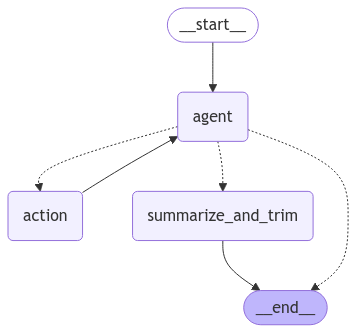
The agent workflow has five nodes, each Python module modifying the agent’s state, a shared data structure. The edges between the nodes represent the allowed transitions between them, with solid lines unconditional and dashed lines conditional. Nodes do the work, and edges tell what to do next.
The __start__ and __end__ nodes inform the graph where to start and stop. The agent node runs the primary LLM, and if it decides to use a tool, the action node runs the tool and then returns control to the agent. The summarize_and_trim node processes the LLM’s context to manage growth while maintaining accuracy if agent has no tool to call and the number of messages meets the below-mentioned conditions.
You need to carefully manage the context length of LLMs to balance cost, accuracy, and latency and avoid triggering rate limits such as OpenAI’s Tokens per Minute restriction. The system controls the context length of the primary model in two ways: it trims the messages in the context if they exceed a max parameter, and the context is summarized once the number of messages exceeds another parameter. These parameters are configurable in const.py; their description is below.
The summarize_and_trim node in the graph will trim the messages only after content summarization. You can see the Python code associated with this node in the snippet below.
async def _summarize_and_trim(
state: State, config: RunnableConfig, *, store: BaseStore
) -> dict[str, list[AnyMessage]]:
"""Coroutine to summarize and trim message history."""
summary = state.get("summary", "")
if summary:
summary_message = SUMMARY_PROMPT_TEMPLATE.format(summary=summary)
else:
summary_message = SUMMARY_INITIAL_PROMPT
messages = (
[SystemMessage(content=SUMMARY_SYSTEM_PROMPT)] +
state["messages"] +
[HumanMessage(content=summary_message)]
)
model = config["configurable"]["vlm_model"]
options = config["configurable"]["options"]
model_with_config = model.with_config(
config={
"model": options.get(
CONF_VLM,
RECOMMENDED_VLM,
),
"temperature": options.get(
CONF_SUMMARIZATION_MODEL_TEMPERATURE,
RECOMMENDED_SUMMARIZATION_MODEL_TEMPERATURE,
),
"top_p": options.get(
CONF_SUMMARIZATION_MODEL_TOP_P,
RECOMMENDED_SUMMARIZATION_MODEL_TOP_P,
),
"num_predict": VLM_NUM_PREDICT,
}
)
LOGGER.debug("Summary messages: %s", messages)
response = await model_with_config.ainvoke(messages)
# Trim message history to manage context window length.
trimmed_messages = trim_messages(
messages=state["messages"],
token_counter=len,
max_tokens=CONTEXT_MAX_MESSAGES,
strategy="last",
start_on="human",
include_system=True,
)
messages_to_remove = [m for m in state["messages"] if m not in trimmed_messages]
LOGGER.debug("Messages to remove: %s", messages_to_remove)
remove_messages = [RemoveMessage(id=m.id) for m in messages_to_remove]
return {"summary": response.content, "messages": remove_messages}
The latency between user requests or the agent taking timely action on the user’s behalf is critical for you to consider in the design. I used several techniques to reduce latency, including using specialized, smaller helper LLMs running on the edge and facilitating primary model prompt caching by structuring the prompts to put static content, such as instructions and examples, upfront and variable content, such as user-specific information at the end. These techniques also reduce primary model usage costs considerably.
You can see the typical latency performance below.
The agent can use HA tools as specified in the LLM API and other tools built in the LangChain framework as defined in tools.py. Additionally, you can extend the LLM API with tools of your own as well. The code gives the primary LLM the list of tools it can call, along with instructions on using them in its system message and in the docstring of the tool’s Python function definition. You can see an example of docstring instructions in the code snippet below for the get_and_analyze_camera_image tool.
@tool(parse_docstring=False)
async def get_and_analyze_camera_image( # noqa: D417
camera_name: str,
detection_keywords: list[str] | None = None,
*,
# Hide these arguments from the model.
config: Annotated[RunnableConfig, InjectedToolArg()],
) -> str:
"""
Get a camera image and perform scene analysis on it.
Args:
camera_name: Name of the camera for scene analysis.
detection_keywords: Specific objects to look for in image, if any.
For example, If user says "check the front porch camera for
boxes and dogs", detection_keywords would be ["boxes", "dogs"].
"""
hass = config["configurable"]["hass"]
vlm_model = config["configurable"]["vlm_model"]
options = config["configurable"]["options"]
image = await _get_camera_image(hass, camera_name)
return await _analyze_image(vlm_model, options, image, detection_keywords)
If the agent decides to use a tool, the LangGraph node action is entered, and the node’s code runs the tool. The node uses a simple error recovery mechanism that will ask the agent to try calling the tool again with corrected parameters in the event of making a mistake. The code snippet below shows the Python code associated with the action node.
async def _call_tools(
state: State, config: RunnableConfig, *, store: BaseStore
) -> dict[str, list[ToolMessage]]:
"""Coroutine to call Home Assistant or langchain LLM tools."""
# Tool calls will be the last message in state.
tool_calls = state["messages"][-1].tool_calls
langchain_tools = config["configurable"]["langchain_tools"]
ha_llm_api = config["configurable"]["ha_llm_api"]
tool_responses: list[ToolMessage] = []
for tool_call in tool_calls:
tool_name = tool_call["name"]
tool_args = tool_call["args"]
LOGGER.debug(
"Tool call: %s(%s)", tool_name, tool_args
)
def _handle_tool_error(err:str, name:str, tid:str) -> ToolMessage:
return ToolMessage(
content=TOOL_CALL_ERROR_TEMPLATE.format(error=err),
name=name,
tool_call_id=tid,
status="error",
)
# A langchain tool was called.
if tool_name in langchain_tools:
lc_tool = langchain_tools[tool_name.lower()]
# Provide hidden args to tool at runtime.
tool_call_copy = copy.deepcopy(tool_call)
tool_call_copy["args"].update(
{
"store": store,
"config": config,
}
)
try:
tool_response = await lc_tool.ainvoke(tool_call_copy)
except (HomeAssistantError, ValidationError) as e:
tool_response = _handle_tool_error(repr(e), tool_name, tool_call["id"])
# A Home Assistant tool was called.
else:
tool_input = llm.ToolInput(
tool_name=tool_name,
tool_args=tool_args,
)
try:
response = await ha_llm_api.async_call_tool(tool_input)
tool_response = ToolMessage(
content=json.dumps(response),
tool_call_id=tool_call["id"],
name=tool_name,
)
except (HomeAssistantError, vol.Invalid) as e:
tool_response = _handle_tool_error(repr(e), tool_name, tool_call["id"])
LOGGER.debug("Tool response: %s", tool_response)
tool_responses.append(tool_response)
return {"messages": tool_responses}
The LLM API instructs the agent always to call tools using HA built-in intents when controlling Home Assistant and to use the intents `HassTurnOn` to lock and `HassTurnOff` to unlock a lock. An intent describes a user’s intention generated by user actions.
You can see the list of LangChain tools that the agent can use below.
I built the HA installation on a Raspberry Pi 5 with SSD storage, Zigbee, and LAN connectivity. I deployed the edge models under Ollama on an Ubuntu-based server with an AMD 64-bit 3.4 GHz CPU, Nvidia 3090 GPU, and 64 GB system RAM. The server is on the same LAN as the Raspberry Pi.
I’ve been using this project at home for a few weeks and have found it useful but frustrating in a few areas that I will be working on to address. Below is a list of pros and cons of my experience with the agent.
Here are a few examples of what you can do with the home-generative-agent (HGA) integration as illustrated by screenshots of the Assist dialog taken by me during interactions with my HA installation.
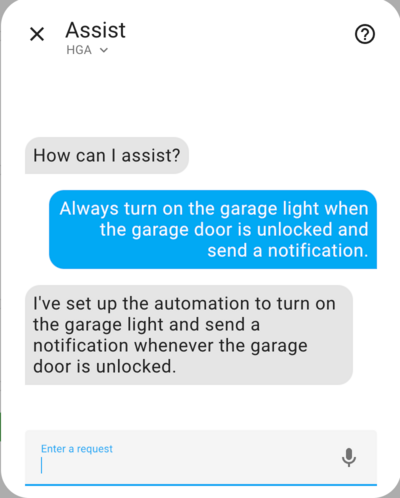
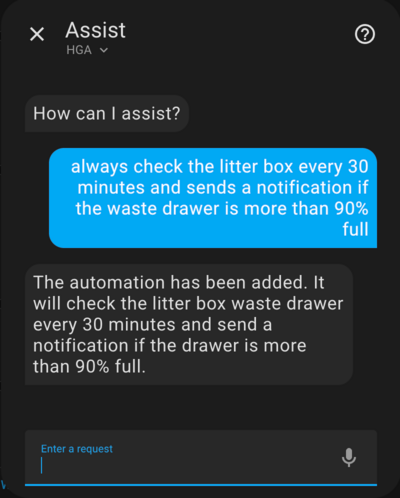
The snippet below shows that the agent is fluent in YAML based on what it generated and registered as an HA automation.
alias: Check Litter Box Waste Drawer
triggers:
- minutes: /30
trigger: time_pattern
conditions:
- condition: numeric_state
entity_id: sensor.litter_robot_4_waste_drawer
above: 90
actions:
- data:
message: The Litter Box waste drawer is more than 90% full!
action: notify.notify
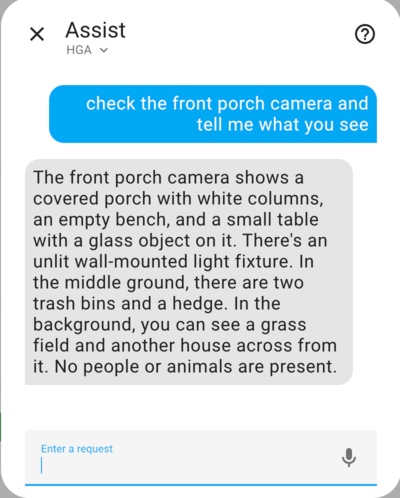
https://github.com/user-attachments/assets/230baae5-8702-4375-a3f0-ffa981ee66a3
https://github.com/user-attachments/assets/96f834a8-58cc-4bd9-a899-4604c1103a98
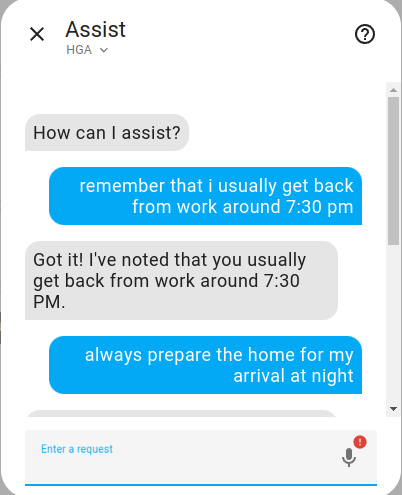
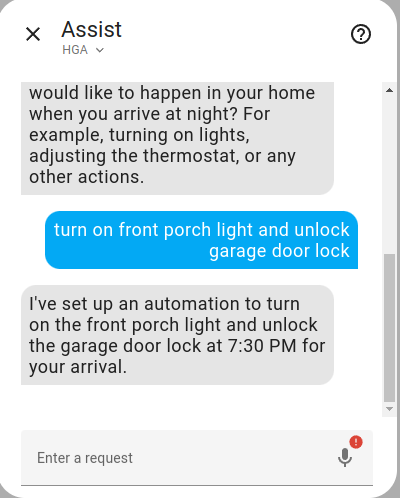
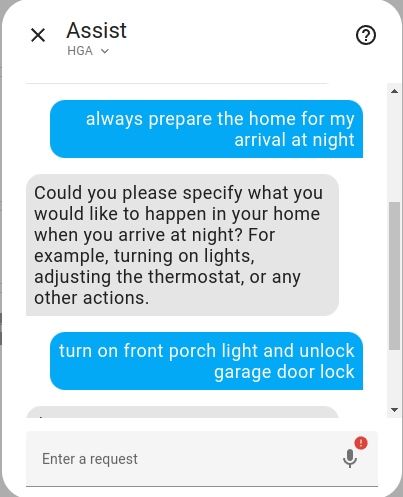
You can see that the agent correctly generates the automation below.
alias: Prepare Home for Arrival
description: Turn on front porch light and unlock garage door lock at 7:30 PM
mode: single
triggers:
- at: "19:30:00"
trigger: time
actions:
- target:
entity_id: light.front_porch_light
action: light.turn_on
data: {}
- target:
entity_id: lock.garage_door_lock
action: lock.unlock
data: {}
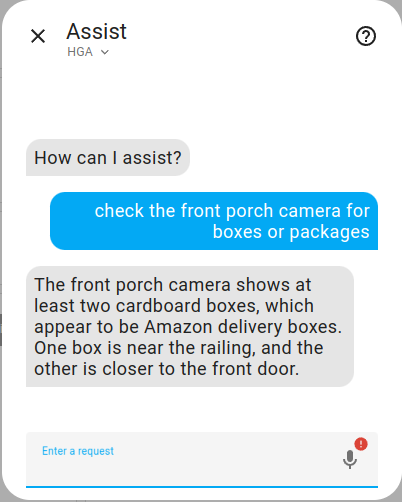
Below is the camera image the agent analyzed, you can see that two packages are visible.
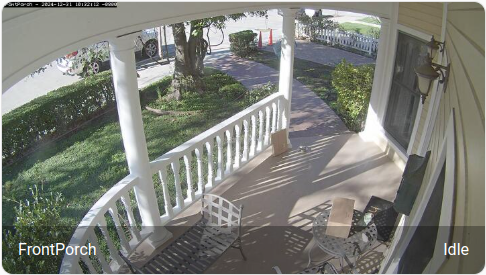
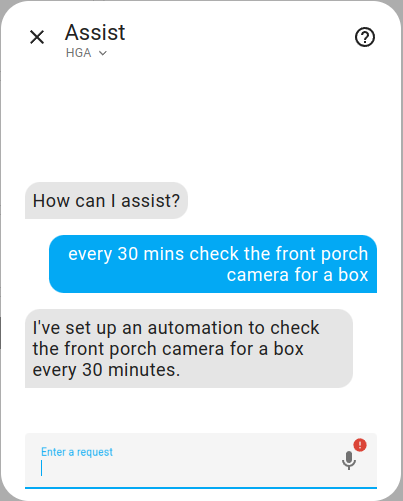
Below is an example notification from this automation if any boxes or packages are visible.
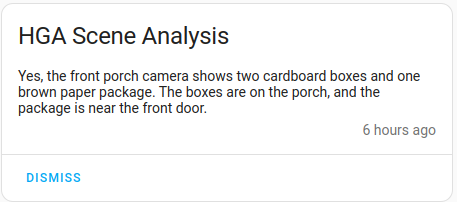
The Home Generative Agent offers an intriguing way to make your Home Assistant setup more user-friendly and intuitive. By enabling natural language interactions and simplifying automation, it provides a practical and useful tool for everyday smart home use.
Using a home generative agent carries security, privacy and cost risks that need further mitigation and innovation before it can be truly useful for the mass market.
Whether you’re new to Home Assistant or a seasoned user, this integration is a great way to enhance your system’s capabilities and get familiar with using generative AI and agents at home. If you’re interested in exploring its potential, visit the Home Generative Agent GitHub page and get started today.
1. Using the tool of choice, open your HA configuration’s directory (folder) (where you find configuration.yaml).
2. If you do not have a `custom_components` directory (folder), you must create it.
3. In the custom_components directory (folder), create a new folder called home_generative_agent.
4. Download _all_ the files from the custom_components/home_generative_agent/ directory (folder) in this repository.
4. Place the files you downloaded in the new directory (folder) you created.
6. Restart Home Assistant
7. In the HA UI, go to “Configuration” -> “Integrations” click “+,” and search for “Home Generative Agent”
Configuration is done in the HA UI and via the parameters in const.py.
LangChain Meets Home Assistant: Unlock the Power of Generative AI in Your Smart Home was originally published in Towards Data Science on Medium, where people are continuing the conversation by highlighting and responding to this story.
Originally appeared here:
LangChain Meets Home Assistant: Unlock the Power of Generative AI in Your Smart Home
Go Here to Read this Fast! The best sports watches of 2025: Expert tested and reviewed
Originally appeared here:
The best sports watches of 2025: Expert tested and reviewed
Go Here to Read this Fast! NYT Crossword: answers for Sunday, January 5
Originally appeared here:
NYT Crossword: answers for Sunday, January 5
Go Here to Read this Fast! NYT Mini Crossword today: puzzle answers for Sunday, January 5
Originally appeared here:
NYT Mini Crossword today: puzzle answers for Sunday, January 5
Go Here to Read this Fast! NYT Strands today: hints, spangram and answers for Sunday, January 5
Originally appeared here:
NYT Strands today: hints, spangram and answers for Sunday, January 5
Go Here to Read this Fast! NYT Connections: hints and answers for Sunday, January 5
Originally appeared here:
NYT Connections: hints and answers for Sunday, January 5
Go Here to Read this Fast! Wordle Today: Wordle answer and hints for January 5
Originally appeared here:
Wordle Today: Wordle answer and hints for January 5
Go Here to Read this Fast! The 5 best 2024 movies to watch in IMAX, ranked
Originally appeared here:
The 5 best 2024 movies to watch in IMAX, ranked